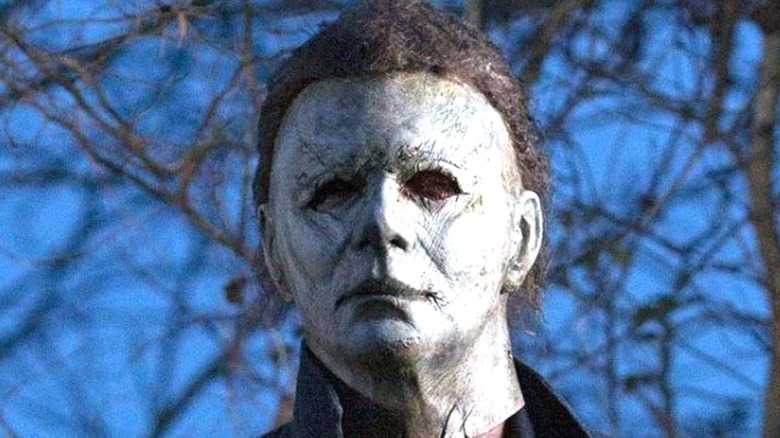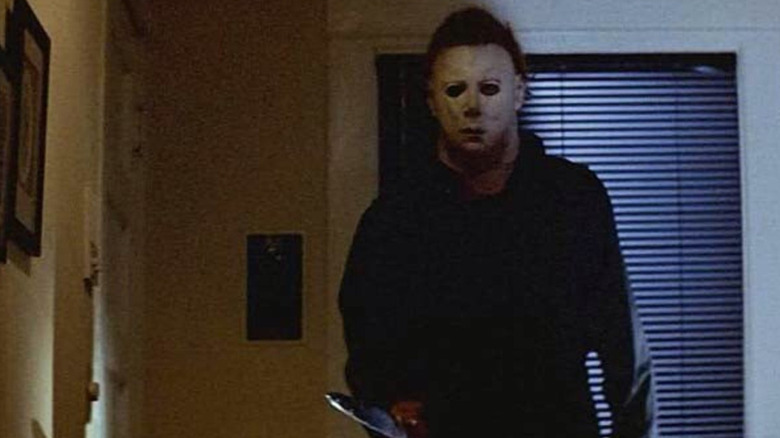The Real Reason Michael Myers Never Runs In The Halloween Movies
With "Halloween Kills" about to premiere on Oct. 15, 2021, Michael Myers will be back to menace a whole new generation of Illinois teenagers, plus Laurie Strode (Jamie Lee Curtis).
"Halloween Kills" is directed by David Gordon Green and co-written by Green, Danny McBride, and Scott Teems. This latest installment in the "Halloween" franchise is a direct sequel to the 2018 film "Halloween" — which was itself a sequel to John Carpenter's 1978 masterpiece, dropping all the other sequels and reboots that had been made before 2018. Green, McBride, and company clearly have a lot of love for the 1978 "Halloween," and they've gone to great lengths to make sure their movies look and feel like the original. As reported by Entertainment Weekly, the filmmakers originally considered filming two "Halloween" movies back-to-back before ultimately deciding to do one at a time, which gives them an opportunity to course-correct if needed.
So, "Halloween Kills" will most likely contain many of the elements that made the original "Halloween" such a hit — most importantly, Michael Myers slicing and dicing his way through helpless victims while wearing his iconic William Shatner mask, without saying a word. To fans, the finer details regarding Myers have been a source of fascination for decades. Most of the stranger facets of the killer's personality are presumably in the movies for a specific purpose, either related to the character's mythology ... or, sometimes, just for filmmaking reasons.
For instance? The way that Michael Myers never seems to run after his victims. He always pursues at a leisurely pace, letting his prey tire themselves out before moving in for the kill. While it's definitely one of Myers' creepier characteristics, it is never explained onscreen. However, there are some theories.
Michael Myers' walking may be related to mental illness
Many people — both characters onscreen, and fans in real-life — have tried to pull back the mask of Michael Myers to diagnose him with real-life mental illnesses, to explain the homicidal behavior he engages in from childhood on. One hypothesis is that his lack of running might be explained by catatonic schizophrenia, or "schizophrenia with catatonic features." Among other symptoms, catatonia is characterized by sluggishness and difficulty moving (via WebMD). To be clear, it's never stated directly in the movies that Michael Myers has schizophrenia or catatonia, but this does appear in various related media. In the novelization of "Halloween," for instance, Michael Myers is described as someone who "hears voices" that command him to hate people — and hearing voices is a classic symptom of schizophrenia.
Then there's a deleted scene from the 1978 original. In it, Michael's (Nick Castle) primary psychiatrist, Dr. Loomis (Donald Pleasance), attends Michael's medical board review and argues against keeping Michael at the Smith's Grove Sanitarium rather than a maximum security prison, fearing Michael will escape — a worry that proves valid. During the scene, one of the board physicians observes that Michael has exhibited catatonia, remaining still for hours at a time.
That might be one of the ways Michael's possible schizophrenia manifests, and it might also be why he never runs after his victims. However, in that same scene, Dr. Loomis, who has observed Michael the most, argues that Michael is faking catatonia to seem harmless.
It's entirely possible that Michael's walking doesn't have an explanation. It could just be that John Carpenter thought it would be creepy, and given the character's enduring appeal, it's hard to argue with that logic.

